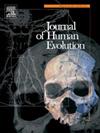肯尼亚图尔卡纳盆地新近系颈石类的牙齿微磨损
IF 3.1
1区 地球科学
Q1 ANTHROPOLOGY
引用次数: 0
摘要
重建单个化石物种的饮食可以帮助我们更好地理解高级灵长类类群的适应性辐射。一些研究人员认为,叶状体是蛇尾类与鼻鞘类分化的关键,叶状体反映了对叶片消耗的适应。其他人对这个模型提出质疑,认为牙齿的功能形态和磨损模式更符合节俭和可能的硬物消费。在这里,我们提出了新的微磨损纹理数据(n = 22),可能有助于讨论。标本来自Buluk (~ 17 Ma,早中新世,Noropithecus bulukensis)和Lothagam (~ 8-4 Ma,晚中新世至上新世早期,Parapapio lothagamensis/sp)。在肯尼亚的图尔卡纳盆地发现了一组现存的分类群,并与之进行了比较。使用白光共聚焦轮廓仪从高分辨率的臼齿复制品中生成点云,并使用尺度敏感分形分析进行分析。这两种化石样本的牙齿微磨损纹理分析结果与现存的食草动物(兽猿)和食草动物(粗猿)的牙齿微磨损纹理分析结果一致,与食果动物/通才动物(猕猴、Papio)和硬物专家(尾猴)的牙齿微磨损纹理分析结果存在显著差异。虽然Noropithecus和Parapapio都将cercopithecoid分支与其他卡鼻目动物的分化时间延后,但这些结果在很大程度上与之前关于Lothagam的早期papionin Parapapio的饮食生态学的研究以及传统的叶子/草的“硬食物”模型一致。一些先前的诺古猿饮食重建表明,他们的饮食是较硬的物体或水果。因此,微磨损结果与之前的布鲁肯梭菌饮食重建结果之间的差异是出乎意料的。这些结果提出的假设可能有助于为这个重要的灵长类超家族的辐射提供新的背景和见解。本文章由计算机程序翻译,如有差异,请以英文原文为准。
Dental microwear of Neogene cercopithecoids from the Turkana Basin, Kenya
Reconstructions of the diets of individual fossil species can help us better understand the adaptive radiations of higher-level primate taxa. Some researchers have posited that folivory was key to the divergence of cercopithecoids from the catarrhine stem, with bilophodonty reflecting an adaptation for leaf consumption. Others have questioned this model, suggesting that dental functional morphology and wear patterns are more consistent with frugivory and perhaps hard-object consumption. Here, we present new microwear texture data (n = 22) that might contribute to the discussion. Specimens were sampled from Buluk (∼17 Ma, Early Miocene, Noropithecus bulukensis) and Lothagam (∼8–4 Ma, Late Miocene to Early Pliocene, Parapapio lothagamensis/sp. indet and fossil Colobinae) in the Turkana Basin, Kenya, and compared with a select group of extant taxa. Point clouds were generated from high-resolution replicas of molar teeth using a white light confocal profiler and analyzed using scale-sensitive fractal analysis. Redults of dental microwear texture analyses for both fossil samples align with those off extant grass (Theropithecus) and leaf (Trachypithecus) eaters and differ significantly from those of frugivores/generalists (Macaca, Papio) and hard-object specialists (Cercocebus). While both Noropithecus and Parapapio postdate the divergence of the cercopithecoid clade from other catarrhines, these results are largely consistent with previous work on the dietary ecology of the early papionin Parapapio from Lothagam and the traditional ‘tough-food’ model of leaves/grasses. Some previous Noropithecus dietary reconstructions indicated a diet of harder objects or fruits. Thus, the discrepancy between the microwear results and previous dietary reconstructions for N. bulukensis is unexpected. These results raise hypotheses that may help provide new context and insights into the radiation of this important superfamily of primates.
求助全文
通过发布文献求助,成功后即可免费获取论文全文。
去求助
来源期刊

Journal of Human Evolution
生物-进化生物学
CiteScore
6.30
自引率
15.60%
发文量
104
审稿时长
3 months
期刊介绍:
The Journal of Human Evolution concentrates on publishing the highest quality papers covering all aspects of human evolution. The central focus is aimed jointly at paleoanthropological work, covering human and primate fossils, and at comparative studies of living species, including both morphological and molecular evidence. These include descriptions of new discoveries, interpretative analyses of new and previously described material, and assessments of the phylogeny and paleobiology of primate species. Submissions should address issues and questions of broad interest in paleoanthropology.
 求助内容:
求助内容: 应助结果提醒方式:
应助结果提醒方式:


